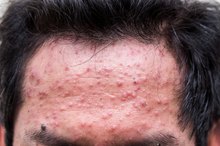Itchiness Behind the Ears
Itchiness behind the ears can be because of a number of causes ranging from allergies to infections. To properly treat itchiness, also called pruritis, you should consult a doctor for a definitive diagnosis. If not properly treated, scratching behind the ears can result in damage to the skin, worsening infection or spread of the condition.
Causes
One of the most common causes of itching behind the ears in adults is dandruff, or seborrheic dermatitis 2. The condition causes flaky, itchy skin on the scalp and can occur behind the ears.
Ringworm can affect the skin behind the ears. According to MayoClinic.com, ringworm causes redness and itchiness and commonly affects toddlers and school-age children.
Head lice, also called pediculosis capitis, can cause intense itching behind the ears and on the scalp. Head lice are extremely contagious.
Other conditions exist that may cause itching behind the ears. Consult your doctor for a clear diagnosis.
- One of the most common causes of itching behind the ears in adults is dandruff, or seborrheic dermatitis 2.
- Head lice, also called pediculosis capitis, can cause intense itching behind the ears and on the scalp.
Risk Factors
What Causes Itchy Ears?
Learn More
According to MayoClinic.com, risk factors for seborrheic dermatitis include yeast infections, stress and fatigue, change of seasons with outbreaks usually worse in the winter, neurological conditions such as:
- Parkinson's disease,
- HIV/AIDS 2
Treatment
Treatment for itchiness behind the ears depends on the cause. Creams and ointments are sometimes prescribed for dermatitis, anti-dandruff shampoos can be used to control seborrhea, oral medications may be given to treat ringworm, and head lice requires treatment with a lice-killing topical solution and removal of the nits.
Always consult your doctor before beginning any treatment for itching behind the ears.
Prognosis
Causes of a Skin Rash on Hands and Feet
Learn More
Most causes of itching behind the ears can be managed or eliminated. With dermatitis, removing the offending allergen can help minimize outbreaks and both ringworm and head lice can be cured with medication. Seborrheic dermatitis may be a lifelong condition that can recur when treatment ends 2.
Warning
Contact a doctor immediately if signs of infection are present.
Related Articles
References
- Merck Manuals Online Medical Library: Dermatitis
- MayoClinic.com: Seborrheic Dermatitis
- Skinsight.com: Head Lice
- Tucker D, Masood S. Seborrheic dermatitis. In: StatPearls Publishing. Updated December 28, 2019.
- Borda LJ, Wikramanayake TC. Seborrheic dermatitis and dandruff: A comprehensive review. J Clin Investig Dermatol. 2015;3(2):10.13188/2373-1044.1000019. doi:10.13188/2373-1044.1000019
- Thayikkannu AB, Kindo AJ, Veeraraghavan M. Malassezia—Can it be ignored?. Indian J Dermatol. 2015;60(4):332-9. doi:10.4103/0019-5154.160475
- Tamer F, Yuksel ME, Sarifakioglu E, Karabag Y. Staphylococcus aureus is the most common bacterial agent of the skin flora of patients with seborrheic dermatitis. Dermatol Pract Concept. 2018 Apr;8(2):80-4. doi:10.5826/dpc.0802a04
- Karakadze MA, Hirt PA, Wikramanayake TC. The genetic basis of seborrhoeic dermatitis: a review. J Eur Acad Dermatol Venereol. 2018;32(4):529-36. doi:10.1111/jdv.14704
- Motswaledi MH, Visser W. The spectrum of HIV-associated infective and inflammatory dermatoses in pigmented skin. Dermatol Clin. 2014;32:211-25. doi:10.1016/j.det.2013.12.006
- Savoia P, Cavaliere G, Zavattaro E, Veronese F, Fava P. Inflammatory cutaneous diseases in renal transplant recipients. Int J Mol Sci. 2016;17(8):1362. doi:10.3390/ijms17081362
- Clark GW, Pope SM, Jaboori KA. Diagnosis and treatment of seborrheic dermatitis. Am Fam Physician. 2015 Feb 1;91(3):185-90.
- McLoone P, Warnock M, Fyfe L. Honey: A realistic antimicrobial for disorders of the skin. J Microbiol Immunol Infect. 2016 Apr;49(2):161-7. doi:10.1016/j.jmii.2015.01.009
- Takagi Y, Ning X, Takahashi A, et al. The efficacy of a pseudo-ceramide and eucalyptus extract containing lotion on dry scalp skin. Clin Cosmet Investig Dermatol. 2018;11:141-8. doi:10.2147/CCID.S158428
- Dobler D, Schmidts T, Wildenhain S, Seewald I, Merzhäuser M, Runkel F. Impact of selected cosmetic ingredients on common microorganisms on healthy human skin. Cosmetics. 2019;6(45):1-13. doi:10.3390/cosmetics6030045
- National Psoriasis Foundation. What's tops in topical steroid treatments?. Updated August 14, 2019.
- U.S. Food and Drug Administration. FDA approves updated labeling with boxed warning and medication guide for two eczema drugs, Elidel and Protopic. January 19, 2006.
- De Souza Leão Kamamoto C, Sanudo A, Hassun KM, Bagatin E. Low-dose oral isotretinoin for moderate to severe seborrhea and seborrheic dermatitis: a randomized comparative trial. Int J Dermatol. 2017;56(1):80-5. doi:10.1111/ijd.13408
- Altman K, Vanness E, Westergaard RP. Cutaneous manifestations of human immunodeficiency virus: a clinical update. Curr Infect Dis Rep. 2015;17(3):464. doi:10.1007/s11908-015-0464-y
- Suárez AL, Feramisco JD, Koo J, Steinhoff M. Psychoneuroimmunology of psychological stress and atopic dermatitis: Pathophysiologic and therapeutic updates. Acta Derm Venereol. 2012;92(1):7–15. doi:10.2340/00015555-1188
Writer Bio
When not working in her family-owned food and bar business, Viola Horne can almost always be found with a cookbook in one hand and a whisk in the other. Horne never tires of entertaining family and friends with both comfort food and unusual delicacies such as garlic cheese smashed potatoes and banana bacon pancakes.







